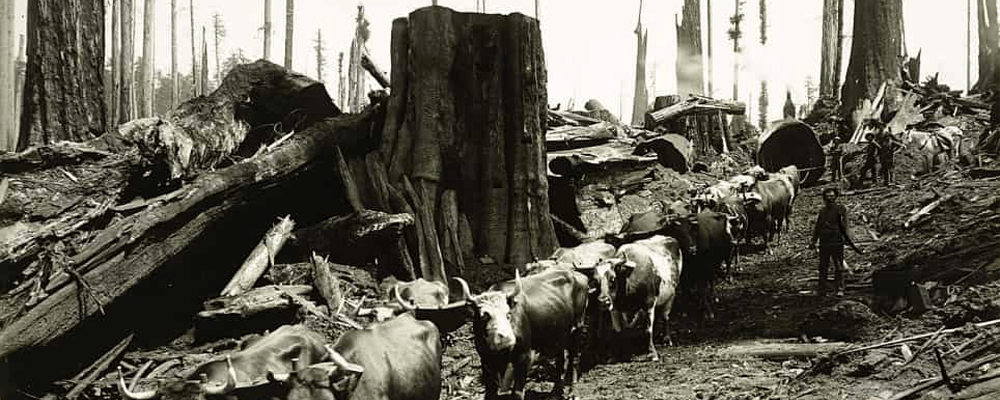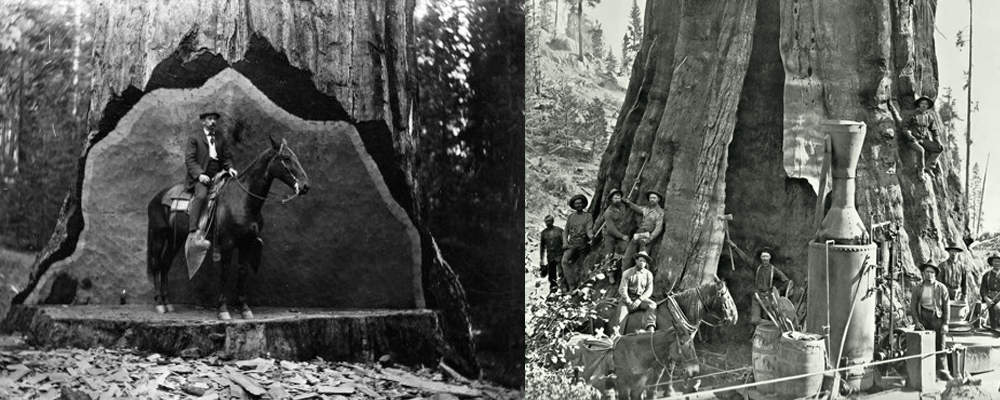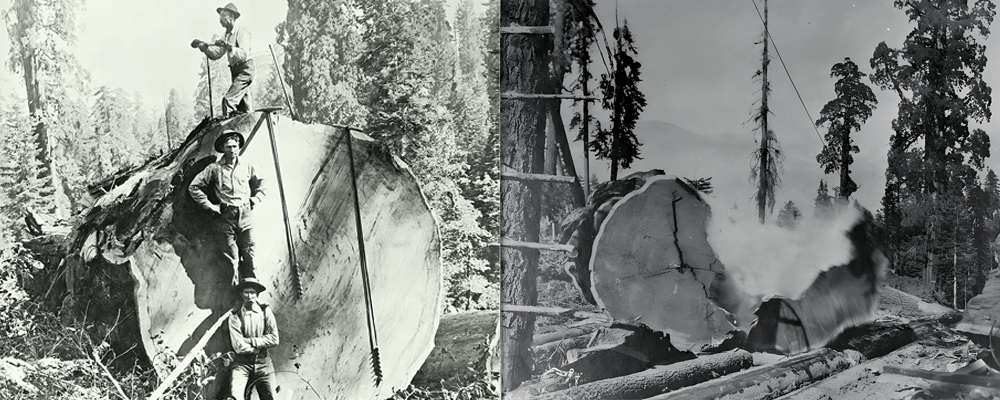The California Gold Rush of the mid-19th century brought many settlers and gold miners to newly emerging cities like San Francisco and Fresno. These newly emerging vibrant cities consumed large amounts of lumber because of the rampant construction. Unfortunately, the new cities often built entirely of wood suffered from frequent fires that were capable of repeatedly destroying entire neighborhoods. This put pressure on the constant supply of new building materials that were used for repairs or the ongoing building boom.
On the coast, timber was obtained from coastal redwoods, which had been harvested by the Spanish since the 18th century; in contrast, in the higher elevations, it was the relatively accessible pine forests.
First attempts to cut down G. Sequoias
The sequoias that grow in the Sierra Nevada were for some time beyond the interest of loggers and speculators, as their location at higher elevations from 900 m above sea level protected them from the direct threat of logging. Furthermore, these trees were little known, as they were only recently discovered in 1833 (more about the discovery of these trees: Redwoods and history). The first historic felling took place practically within months of discovery, though, with a sequoia called the Discovery tree falling victim in June 1853.-min.png) Photo: Discovery Tree
Photo: Discovery Tree
The felling of the tree itself was undertaken by a party of 5 men who began drilling around the circumference of the tree trunk until, after 23 days of felling work, it fell to the ground. This is the site that is now included in the Yosemite National Park area. However, this was a very sporadic activity that failed to threaten the population of these trees in any way. Logging of giant trees before the railroad and the expansion of the steam engine was sporadic, and many times there was also a search for a way to effectively cut these trees at all. There are also such practices where a certain Snediker lumberman figured out a way of tapping these large trees in such a way that instead of going into the chopping and felling of the trunk, they concentrated on the subterranean part of the tree. They dug under the tree with, picks and shovels and destroyed its roots with axes and saws.
Twilight over Mammoth Sequoias
From 1872 things begin to pick up speed as the railroad extends up the Sierra Nevada slopes, sometimes to sequoia groves. In addition, in the meantime, mountain access roads were also built, which were able to provide access to less accessible places. These are the southern sites in the Converse Basin area, near present-day Sequoia National Park.
A bright moment in the protection of these trees came 2 years later in the city of Fresno, where a law was voted into law that prohibits burning, debarking, sawing or otherwise damaging trees that are more than 4.8m thick in designated areas. As it would later turn out this law was well intentioned, but enforcement was difficult to achieve. The fine for breaking this law was $300, which would be $8,000 today. There is a recorded case where a certain Mr. Vivian, before he ever started sawing, first paid the fine and then went into the mountains to cut down a huge sequoias.
At this time, however, the sawing of large trees and forests is beginning to take off. John Muir the great enthusiast and conservationist, otherwise known as the father of the national parks, notes in 1875 that Heide's sawmills in the groves thump and howl like an evil spirit. When they sawed a redwood, it shattered like glass, and the material loss to the sawmill could be 25-50% of a single tree.
Heide's sawmill primarily targeted old groves with mammoth trees, resulting in the death of hundreds of these large trees in 4 years of sawing. With the advent of the steam gator also comes a great speed up from previous years in the cutting of raw logs.
Clearcuttings in this area even brought the name Gig Stump. In 6 years of logging they managed to extract hundreds of redwoods, after which you can still see large stumps sticking out of the ground, which can be several meters in diameter.
The very largest trees were lucky and were left out of the logging, as the effort to saw such a tree was not worth it. Primarily, the loggers targeted trees that were around 3 m thick. These were cut after falling and placed on oil-painted skids, which were pulled by ox teams to designated sawmills in local groves.
Legislative change
However, large-scale logging has been hampered by the lack of enabling legislation. The American public at the time was of the opinion that 'the nation can only be enriched if individuals are enriched'. This led to the passage of the Timber and Stone Act, which made it possible for mining companies to legally acquire acreage. However, the Act vaguely limited the area that an individual could acquire to the extent of 65ha of land at a price of $30 per hectare in today's terms. However, the loophole in the law was cleverly exploited by the logging companies who hired labourers in local pubs to go and claim the acreage, which they later transferred to the logging company.
Smith and Moore Logging Company
As a result, this single company acquired an area of 103 KM2. The loggers did not hesitate for a second and immediately set about building steam saws and a dam that would supply water to a trough, which would allow the timber to flow down to the valley for further processing. The company spared no expense and also purchased a 36-ton locomotive, but it had to be dismantled in town and brought to the mountains in pieces on horse-drawn wagons. A railroad was even built for the locomotive right up to Converse Basin Grove, but the economic crisis was just coming on at the time, halting construction work for 2 years.
Unlike the trees, however, the crisis is not survived by the Smith and Moore Logging Company and is bought out by another company, which in 1897 begins the largest ever logging of these massive trees.
Methods of harvesting mammoth sequoias
The axes and 6m long saws come into play, which can bring most of the trees in the sawing area down to the ground. Despite mechanisation, axes still have a major say in felling, especially when a huge directional notch has to be made in the trunk to guide the tree's fall. Historic photographs are being taken of a man sitting on a horse being able to fit into such a cut. Time continues to pass and innovations in sawing continue to flow into all areas of logging. Ox-drawn teams are being converted into steam-powered winches that gain the nickname iron donkeys.
Photo left: Directional notch cutted by hand with axes. Photo right: Steam winch
There are even cases where bundles of dynamite are placed in parts of a cut tree, which blows the large pieces into smaller pieces.
In 10 years the local ghats process almost half a million (471 thousand) cubic meters of wood, 21% (157 thousand) of this volume being wood from sequoias.
Photo Left: Drilling tools for dynamite holes. Photo right: Blasting logs
In the logging areas it was not just trees that were missing. It was also the much-desired profit that made all these things happen. Large investments in steam engines, railroads, water troughs, and large timber losses from the sequoias drove the logging companies into bankruptcy. However, this did not deter others from continuing to cut and destroy the surrounding forests until the 1920s. The only profitable ones were the smaller sawmills that made fence posts, vine pegs, or shingles for roofs from ancient giant trees.
During this period they also cut down the largest redwood to date, which is still considered one of the largest trees ever to grow.Sequoia with name General Noble 
Photo: Logged General Noble
Gradually, logging has been declining due to various factors such as the unprofitability of logging, the creation of national parks and also the emerging public pressure. However, the destruction was complete... In almost 26 years of harvesting, only a handful of trees remain as mute witnesses of what has happened to the second largest sequoia grove.
Sources:
Tweed, William C. (2016). King Sequoia: The Tree that Inspired a Nation, Created Our National Park System, and Changed the Way We Think about Nature. Heyday. ISBN-13: 978-1597143516.
